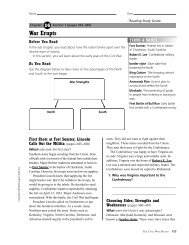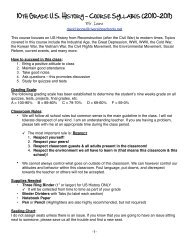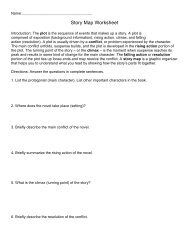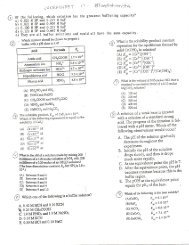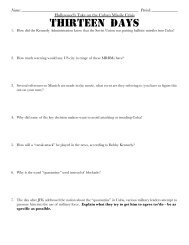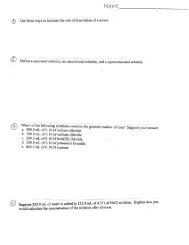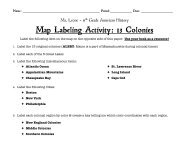Chapter 16 Text
Chapter 16 Text
Chapter 16 Text
You also want an ePaper? Increase the reach of your titles
YUMPU automatically turns print PDFs into web optimized ePapers that Google loves.
gecause the oxidation number of the central atom increases as the number of<br />
attached O atoms increases, this correlation can be stated in an equivalent way:<br />
In a series of oxyacids, the acidity increases as the oxidation number of the central<br />
atom increases,<br />
<strong>16</strong>.10 Acid-Base Behavior and Chemical Structure 647<br />
SAMPLE EXERCISE <strong>16</strong>.19<br />
Arrange the compounds in each of the following series in order of increasing acid<br />
strength: (a) AsH3/ HI, NaH, H2O; (b) H2SeO3, H2SeO4, H2O.<br />
Solution<br />
Analyze: We are asked to arrange two sets of compounds in order from weakest acid<br />
to strongest acid.<br />
Plan: For the binary acids in part (a), we will consider the electronegativities of As, I,<br />
Ma, and O, respectively. For the oxyacids in part (b), we will consider the number of<br />
oxygen atoms bonded to the central atom and the similarities between the Se-containing<br />
compounds and some more familiar acids.<br />
Solve: (a) The elements from the left side of the periodic table form the most basic<br />
binary hydrogen compounds because the hydrogen in these compounds carries a negative<br />
charge. Thus NaH should be the most basic compound on the list. Because arsenic<br />
is less electronegative than oxygen, we might expect that AsH3 would be a weak base<br />
toward water. That is also what we would predict by an extension of the trends shown<br />
in Figure <strong>16</strong>.13. Further, we expect that the binary hydrogen compounds of the halogens,<br />
as the most electronegative element in each period, will be acidic relative to<br />
water. In fact, HI is one of the strong acids in water. Thus the order of increasing acidity<br />
is NaH < AsH3 < H2O < HI.<br />
(b) The acidity of oxyacids increases as the number of oxygen atoms bonded to the<br />
central atom increases. Thus, H2SeC>4 will be a stronger acid than H2SeO3; in fact, the<br />
Se atom in H2SeO4 is in its maximum positive oxidation state, and so we expect it to<br />
be a comparatively strong acid, much like H2SO4. H2SeO3 is an oxy acid of a nonmetal<br />
that is similar to H2SO3. As such, we expect that H2SeO3 is able to donate a proton to<br />
H2O, indicating that H2SeO3 is a stronger acid than H2O, Thus, the order of increasing<br />
acidity is H2O < H2SeO3 < H2SeO4.<br />
PRACTICE EXERCISE<br />
In each of the following pairs choose the compound that leads to the more acidic (or<br />
less basic) solution: (a) HBr, HF; (b) FH3, H2S; (c) HNO2, HNO3; (d) H2SO3, H2SeO3.<br />
Answers; (a) HBr; (b) H2S; (c) HNO3; (b) H2SO3<br />
Carboxylic Acids<br />
Another large group of acids is illustrated by acetic acid<br />
H :0:<br />
I II ..<br />
H—C—C—O—H<br />
H<br />
The portion of the structure shown in blue is called the carboxyl group, which is<br />
often written as COOH. Thus, the chemical formula of acetic acid is often written<br />
as CH3COOH, where only the hydrogen atom in the carboxyl group can be<br />
ionized. Acids that contain a carboxyl group are called carboxylic acids, and<br />
they form the largest category of organic acids. Formic acid and benzoic acid,<br />
whose structures are drawn in the margin, are further examples of this large and<br />
important category of acids.<br />
Acetic acid (CH3COOH) is a weak acid (Ka = 1.8 X 1(T5). Methanol<br />
(CH3OH), on the other hand, is not an acid in water. Two factors contribute to<br />
the acidic behavior of carboxylic acids. First, the additional oxygen atom attached<br />
to the carboxyl group carbon draws electron density from the O—H bond,<br />
increasing its polarity and helping to stabilize the conjugate base. Second, the<br />
conjugate base of a carboxylic acid (a carboxylate union) can exhibit resonance<br />
Carboxylic acids are organic<br />
compounds that have the general<br />
formula R — COOH, where R is either<br />
a hydrogen or a chain of carbonbased<br />
groups.<br />
H—C—O—H<br />
Formic acid<br />
Benzoic acid



